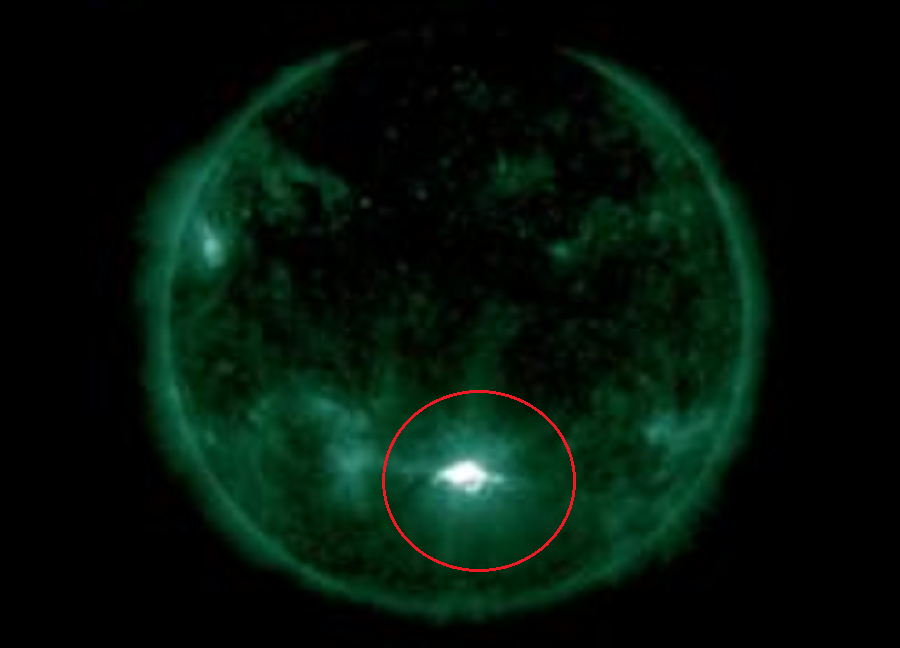
A massive X-class solar flare erupted from the sun today and it appears an associated coronal mass ejection from the Sun could reach Earth on October 30 or 31, bringing about a geomagnetic storm on Earth around Halloween. A Radiation Storm associated with the explosion is impacting Earth right now.
The largest solar flares are known as “X-class flares” based on a classification system that divides solar flares according to their strength. The smallest ones are A-class , followed by B, C, M and X. Similar to the Richter scale for earthquakes, each letter represents a 10-fold increase in energy output. As a result, today’s X-class flare is ten times an M and 100 times a C class flare. Within each letter class there is a finer scale from 1 to 9. Today’s solar flare is rated an X1. Today’s X-Class flare came from active region #2887 on the Sun, a growing sunspot area first detected days ago.
According to NOAA’s Space Weather Prediction Center (SWPC), a S1 Radiation Storm began at 1:40 pm ET today; due to this event, they’ve issued a Radiation Storm Warning through 8:40 am ET tomorrow.
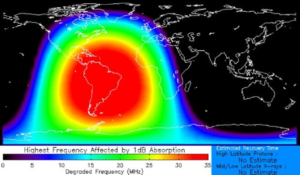
According to the SWPC, Solar Radiation Storms occur when a large-scale magnetic eruption accelerates charged particles in the solar atmosphere to very high velocities. The most important particles are protons which can get accelerated to large fractions of the speed of light. At these velocities, the protons can rush to Earth in less than an hour after the explosion. When these particles reach Earth, the fast moving protons penetrate the magnetosphere that shields Earth from lower energy charged particles. Once inside the magnetosphere, the particles are guided down the magnetic field lines and penetrate into the atmosphere near the north and south poles.
Solar Radiation Storms can cause several impacts near Earth. When energetic protons collide with satellites or humans in space, they can penetrate deep into the object that they collide with and cause damage to electronic circuits or biological DNA. During the more extreme Solar Radiation Storms, passengers and crew in high flying aircraft at high latitudes may be exposed to radiation risk. During such storms, commercial aircraft can be routed away from areas with the greatest radiation risks. According to the SWPC, when the energetic protons collide with the atmosphere, they ionize the atoms and molecules thus creating free electrons. These electrons create a layer near the bottom of the ionosphere that can absorb High Frequency (HF) radio waves making radio communication difficult or impossible.
NOAA’s SWPC categorizes Solar Radiation Storms using their Space Weather Scale on a scale from S1-S5. A Solar Radiation Storm can persist for time periods ranging from hours to days. Currently, the Radiation Storm is considered an S1 storm.

Image: NASA/Mary Pat Hrybyk-Keith
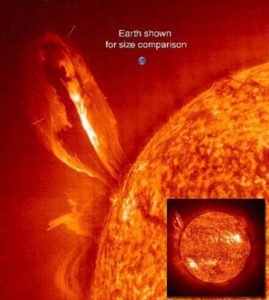
Beyond today’s Radiation Storm, scientists are monitoring and forecasting what, if any, impacts the coronal mass ejection from today’s explosion will have on Earth. A coronal mass ejection, or CME for short, can create a Geomagnetic Storm on the Earth. Geomagnetic storms are rated on a 1-5 scale, with 1 being the weakest and 5 having the most potential for damage. Even a G1 geomagnetic storm could create issues: there could be weak power grid fluctuations and minor impacts on satellite operations. Aurora, also known as the “Northern Lights”, could be visible at high latitudes from northern Michigan and Maine to points north. Impacts and aurora change as the geomagnetic storm scale increase. G5 class geomagnetic storms are rare with the last one occurring in 1859. If such a storm were to hit today with modern life’s dependency on electricity and electronics, it would be extremely catastrophic.
At this time, the Space Weather Prediction Center reports that Earth can expect a G3 – Strong Storm from today’s unfolding solar event; the geomagnetic storm conditions will arrive sometime late on the 30th or 31st.
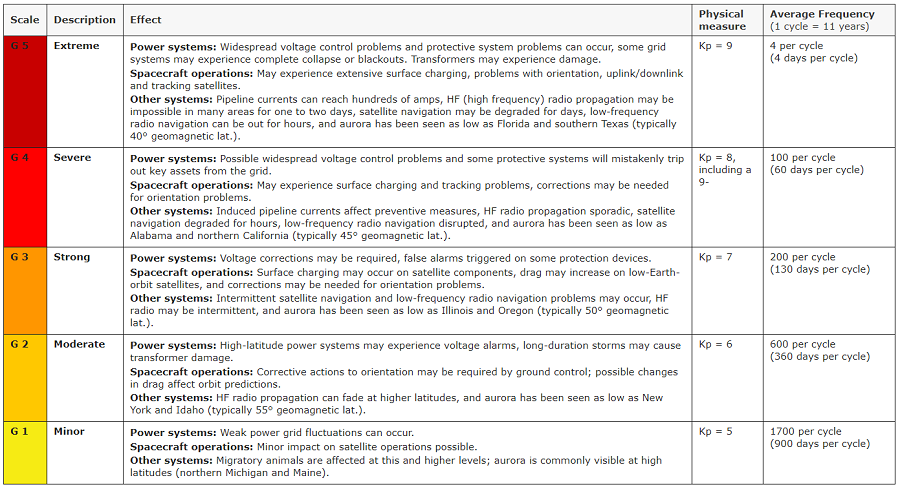
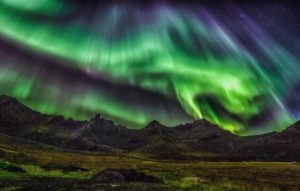
NOAA forecasters analyze a variety of solar data from spacecraft to determine what impacts a geomagnetic storm could produce. If Earth is experiencing the effects of a coronal hole and a coronal mass ejection is forecasted to impact Earth, the combined effects could result in a more significant impact and more intense geomagnetic storming. Analyzing data from the DSCOVER and ACE satellite is one way forecasters can tell when the enhanced solar wind from a coronal hole is about to arrive at Earth. A few things they look for in the data to determine when the enhanced solar wind is arriving at Earth:
• Solar wind speed increases
• Temperature increases
• Particle density decreases
• Interplanetary magnetic field (IMF) strength increases
While these solar events can help illuminate the sky with stunning aurora, they can also do considerable harm to electronics, electrical grids, and satellite and radio communications.
The 1859 incident, which occurred on September 1-2 in 1859, is also known as the “Carrington Event.” This event unfolded as powerful geomagnetic storm struck Earth during Solar Cycle 10. A CME hit the Earth and induced the largest geomagnetic storm on record. The storm was so intense it created extremely bright, vivid aurora throughout the planet: people in California thought the sun rose early, people in the northeastern U.S. could read a newspaper at night from the aurora’s bright light, and people as far south as Hawaii and south-central Mexico could see the aurora in the sky.
The event severely damaged the limited electrical and communication lines that existed at that time; telegraph systems around the world failed, with some telegraph operators reporting they received electric shocks.
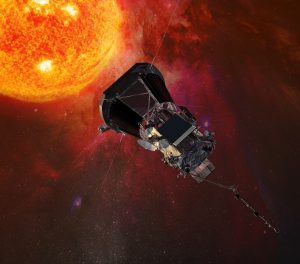
A June 2013 study by Lloyd’s of London and Atmospheric and Environmental Research (AER) in the U.S. showed that if the Carrington event happened in modern times, damages in the U.S. could exceed $2.6 trillion, roughly 15% of the nation’s annual GDP.
While typically known for their weather forecasts, the National Oceanic and Atmospheric Administration (NOAA) and its National Weather Service (NWS) is also responsible for “space weather.” While there are private companies and other agencies that monitor and forecast space weather, the official source for alerts and warnings of the space environment is the Space Weather Prediction Center (SWPC). The SWPC is located in Boulder, Colorado and is a service center of the NWS, which is part of NOAA. The Space Weather Prediction Center is also one of nine National Centers for Environmental Prediction (NCEP) as they monitor current space weather activity 24/7, 365 days a year.
Article From & Read More ( Massive X Class Flare Erupts from Sun; G3- Strong Geomagnetic Storm Possible Halloween; Radiation Storm Warning in Effect - Weatherboy )https://ift.tt/3CpUHRn
Science
No comments:
Post a Comment